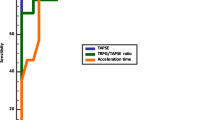Abstract
Background
We aimed to examine the value of NT-proBNP, pulmonary artery systolic pressure (PASP), blood pressure index (BPI), and mean arterial pressure (MAP) in the determination of right ventricular dysfunction (RVD) in patients with acute pulmonary embolism (APE).
Patients and methods
A total of 547 patients diagnosed with APE were included in the study. Demographic characteristics and comorbid conditions of patients were recorded in patient files. For blood pressure measurement, a calibrated digital blood pressure monitor was used at regular intervals. Blood samples were taken from patients at the time of admission for hemogram, biochemical, and hemostasis blood tests. Echocardiography was performed on all patients to detect RVD and evaluate pulmonary artery pressure.
Results
PASP (p < 0.001), MAP (p < 0.001), diastolic blood pressure (p < 0.001), D‑dimer (p = 0.001), NT-proBNP (p = 0.001), white blood cell (p < 0.001), and platelet (p = 0.001) counts were higher in APE patients with RVD compared with those without RVD, whereas the mean BPI level (p < 0.001) was lower. BPI had a negative correlation with PASP, NT-proBNP, platelet count, and triglyceride levels in patients with RVD. In regression analysis, BPI and PASP were found to be independent predictors of RVD. In receiver operating characteristic curve analysis, BPI (AUC ± SE = 0.975 ± 0.006; p < 0.001) was found to be the best predictor of RVD with a higher sensitivity (92.8%) and specificity (100%).
Conclusion
We found that BPI had a better diagnostic discrimination for RVD compared with PASP and NT-proBNP.
Zusammenfassung
Hintergrund
Ziel war es, die Überlegenheit von NT-proBNP, pulmonalarteriellem systolischem Druck (PASP), Blutdruckindex (BPI) oder mittlerem arteriellem Druck (MAP) zur Untersuchung einer rechtsventrikulären Dysfunktion (RVD) bei Patienten mit akuter Lungenembolie (APE) zu ermitteln.
Patienten und Methoden
Insgesamt wurden 547 Patienten mit APE in die Studie aufgenommen. Demographische Merkmale und Begleiterkrankungen der Patienten wurden in den Krankenakten dokumentiert. Zur Blutdruckmessung wurde in regelmäßigen Abständen ein kalibriertes digitales Blutdruckmessgerät verwendet. Bei Aufnahme ins Krankenhaus wurde den Patienten für ein Blutbild, biochemische und Gerinnungsparameter Blut entnommen. Eine Echokardiographie wurde bei allen Patienten durchgeführt, um ggf. eine RVD zu diagnostizieren und den pulmonalarteriellen Druck zu beurteilen.
Ergebnisse
PASP (p < 0,001), MAP (p < 0,001), diastolischer Blutdruck (p < 0,001), D‑Dimer (p = 0,001), NT-proBNP (p = 0,001), Leukozyten- (p < 0,001) und Thrombozytenzahl (p = 0,001) waren bei APE-Patienten mit RVD höher als bei Patienten ohne RVD, der mittlere BPI-Wert dagegen (p < 0,001) war niedriger. Der BPI wies eine negative Korrelation mit PASP, NT-proBNP, Thrombozytenzahl und Triglyzeridwerten bei Patienten mit RVD auf. In der Regressionsanalyse stellten sich BPI und PASP als unabhängige Prädiktoren einer RVD heraus. In der Receiver-Operating-Characteristic-Curve-Analyse erwies sich der BPI (Fläche unter der Kurve ± Standardfehler, AUC ± SE = 0,975 ± 0,006; p < 0,001) mit einer höheren Sensitivität (92,8%) und Spezifität (100%) als der beste Prädiktor einer RVD.
Schlussfolgerung
Die Autoren stellten fest, dass der BPI sich besser zur diagnostischen Abgrenzung einer RVD eignet als PASP und NT-proBNP.

Similar content being viewed by others
References
Silverstein MD, Heit JA, Mohr DN et al (1998) Trends in the incidence of deep vein thrombosis and pulmonary embolism: a 25-year population-based study. Arch Intern Med 158(6):585–593
Cho JH, Kutti Sridharan G, Kim SH et al (2014) Right ventricular dysfunction as an echocardiographic prognostic factor in hemodynamically stable patients with acute pulmonary embolism: a meta-analysis. BMC Cardiovasc Disord 14:64
Kucher N, Rossi E, De Rosa M, Goldhaber SZ (2006) Massive pulmonary embolism. Circulation 113(4):577–582
Alpert JS, Smith R, Carlson J et al (1976) Mortality in patients treated for pulmonary embolism. JAMA 236(13):1477–1480
Grifoni S, Olivotto I, Cecchini P et al (2000) Short-term clinical outcome of patients with acute pulmonary embolism, normal blood pressure, and echocardiographic right ventricular dysfunction. Circulation 101(24):2817–2822
Meyer T, Binder L, Hruska N et al (2000) Cardiac troponin I elevation in acute pulmonary embolism is associated with right ventricular dysfunction. J Am Coll Cardiol 36(5):1632–1636
Pieralli F, Olivotto I, Vanni S et al (2006) Usefulness of bedside testing for brain natriuretic peptide to identify right ventricular dysfunction and outcome in normotensive patients with acute pulmonary embolism. Am J Cardiol 97(9):1386–1390
Dursunoglu N, Dursunoglu D, Yildiz AI, Rota S (2016) Evaluation of cardiac biomarkers and right ventricular dysfunction in patients with acute pulmonary embolism. Anatol J Cardiol 16(4):276–282
Coutance G, Cauderlier E, Ehtisham J et al (2011) The prognostic value of markers of right ventricular dysfunction in pulmonary embolism: a meta-analysis. Crit Care 15(2):R103
Torbicki A, Perrier A, Konstantinides S et al (2008) Guidelines on the diagnosis and management of acute pulmonary embolism: the Task Force for the Diagnosis and Management of Acute Pulmonary Embolism of the European Society of Cardiology (ESC). Eur Heart J 29(18):2276–2315
Friedewald WT, Levy RI, Fredrickson DS (1972) Estimation of the concentration of low-density lipoprotein cholesterol in plasma, without use of the preparative ultracentrifuge. Clin Chem 18(6):499–502
O’Brien E, Atkins N, Stergiou G et al (2010) European Society of Hypertension International Protocol revision 2010 for the validation of blood pressure measuring devices in adults. Blood Press Monit 15(1):23–38
Ates H, Ates I, Bozkurt B et al (2016) What is the most reliable marker in the differential diagnosis of pulmonary embolism and community-acquired pneumonia? Blood Coagul Fibrinolysis 27(3):252–258
Sakaki K, Nie M, Sasahara A et al (2016) Emergency surgery for acute pulmonary embolism. Kyobu Geka 69(3):197–200
Henzler T, Roeger S, Meyer M et al (2012) Pulmonary embolism: CT signs and cardiac biomarkers for predicting right ventricular dysfunction. Eur Respir J 39(4):919–926
Wong LF, Akram AR, McGurk S et al (2012) Thrombus load and acute right ventricular failure in pulmonary embolism: correlation and demonstration of a “tipping point” on CT pulmonary angiography. Br J Radiol 85(1019):1471–1476
Abul Y, Ozsu S, Karakurt S et al (2013) Prediction of right ventricular dysfunction from radiographic estimates of right descending pulmonary artery in hemodynamically stable pulmonary embolism patients. Cardiol J 20(2):184–189
Staskiewicz G, Czekajska-Chehab E, Uhlig S et al (2013) Logistic regression model for identification of right ventricular dysfunction in patients with acute pulmonary embolism by means of computed tomography. Eur J Radiol 82(8):1236–1239
Graner M, Harjola VP, Selander T et al (2016) N‑terminal pro-brain natriuretic peptide, high-sensitivity troponin and pulmonary artery clot score as predictors of right ventricular dysfunction in echocardiography. Heart Lung Circ 25(6):592–599
Rodrigues AC, Cordovil A, Monaco C et al (2013) Right ventricular assessment by Tissue-Doppler echocardiography in acute pulmonary embolism. Arq Bras Cardiol 100(6):524–530
Varol K, Gumus C, Yucel H et al (2015) Correlation of right ventricular dysfunction on acute pulmonary embolism with pulmonary artery computed tomography obstruction index ratio (PACTOIR) and comparison with echocardiography. Jpn J Radiol 33(6):311–316
Praveen Kumar BS, Rajasekhar D, Vanajakshamma V (2014) Study of clinical, radiological and echocardiographic features and correlation of Qanadli CT index with RV dysfunction and outcomes in pulmonary embolism. Indian Heart J 66(6):629–634
Aribas A, Keskin S, Akilli H et al (2014) The use of axial diameters and CT obstruction scores for determining echocardiographic right ventricular dysfunction in patients with acute pulmonary embolism. Jpn J Radiol 32(8):451–460
Ates I, Bulut M, Ozkayar N, Dede F (2015) Association between high platelet indices and proteinuria in patients with hypertension. Ann Lab Med 35(6):630–634
Mebazaa A, Karpati P, Renaud E, Algotsson L (2004) Acute right ventricular failure – from pathophysiology to new treatments. Intensive Care Med 30(2):185–196
Chin KM, Kim NH, Rubin LJ (2005) The right ventricle in pulmonary hypertension. Coron Artery Dis 16(1):13–18
Matthews JC, McLaughlin V (2008) Acute right ventricular failure in the setting of acute pulmonary embolism or chronic pulmonary hypertension: a detailed review of the pathophysiology, diagnosis, and management. Curr Cardiol Rev 4(1):49–59
Author information
Authors and Affiliations
Corresponding author
Ethics declarations
Conflict of interest
H. Ates, I. Ates, H. Kundi, and F.M. Yilmaz declare that they have no competing interests.
The present study was designed in accordance with the Helsinki Declaration. It was approved by the local Ethics Board and Research Committee. Written consent was obtained from all participants included in the study.
Additional information
Author contribution. H. Ates, I. Ates, H. Kundi, and F.M. Yilmaz designed the research. I. Ates and F.M. Yilmaz analyzed the data. H. Ates and I. Ates wrote the paper. All authors take responsibility for the interpretation of data and critical revision of the manuscript for important intellectual content. H. Ates takes full responsibility for the integrity of the data and analyses.
Rights and permissions
About this article
Cite this article
Ates, H., Ates, I., Kundi, H. et al. Choice of marker for assessment of RV dysfunction in acute pulmonary embolism. Herz 42, 758–765 (2017). https://doi.org/10.1007/s00059-016-4513-6
Received:
Revised:
Accepted:
Published:
Issue Date:
DOI: https://doi.org/10.1007/s00059-016-4513-6




